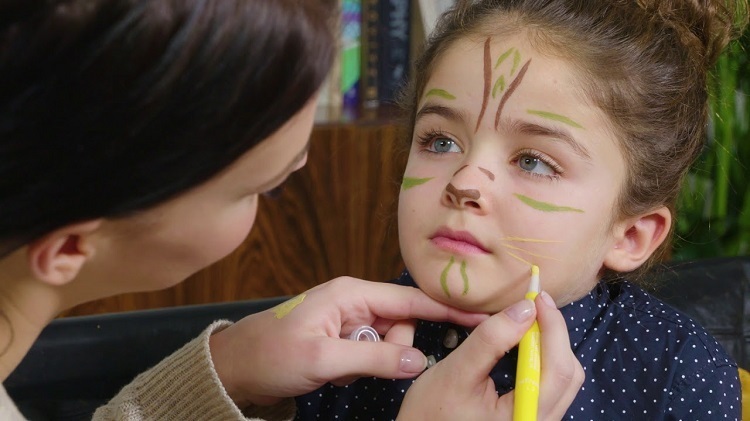Are you looking to start building your face painting kit for small parties, or perhaps just a little at-home practice? The supplies are extremely fun to buy but the expense of brushes can add up quick – especially if you aren’t sure which ones are the essentials and which are the fun extras. This quick guide will help to explain the purpose behind each brush type so you can compile the best possible starter kit.
Brushes
Flats, rounds, and chisel brushes are the three main categories of brushes – we’ll talk about the specialty detail brushes a little later. Flats are best for those thick lines and gradients, rounded brushes for thicker fills and general details, and chisels are great for tapered line work and complex shapes.
It is helpful to have at least one medium size of each but try to add small and large counterparts at your first opportunity. If you want to use your brushes with a rainbow cake, make sure that the brush width matches the width of the paint tin.
Detailers
A simple set of flats, rounds, and chisels should help you create the most basic designs. To make the process go faster (extremely important for parties and professional gigs) you might want to consider investing in a few detailers. We’ll list the most common ones below.
- Fine Point – These look just like paintbrushes and work the same way. Brushes with a fine point, whether flat or round, serve as the first choice for line work. Pointed brushes with stiffer bristles will provide more precision and softer bristles are better for those flowing, tapered details. A good fine point is an essential part of any kit.
- Triangle – Also called “petal brushes”, triangle brushes come to a tapered point right in the middle. These brushes are great for small flower petal / tear drop shapes and create clean line work with tapered ends.
- Ribbon – Ribbon brushes have a v-shaped cut in the middle. As the name implies, these are an easy way to create a ribbon effect. You can also use them to create a “false eyelash” look or to add flair to your tiger stripes.
- Hollow – Hollow brushes are a specialty brush. They look like normal round brushes from the side, but there are no bristles on the inside portion. Hollow brushes allow for the effortless creation of cheetah spots or chain links.
- Wisp – Fan/rake/wisp brushes are another specialty brush, but these have a very wide range of application. These brushes create tiny equally spaced dots or fan shapes depending on how you use them. Dab to create dotted lines and drag for fuzzy fur.
Sponges
Don’t get too wrapped up in the brush shopping! Sponges play an important role in every face painting tool kit. Sponges are effective, versatile, and exceptionally inexpensive, the perfect starting point for beginners. You can do many of the same techniques with a sponge as you can a brush, from full color and gradients to basic line work.
The cheapest and most versatile sponges are the flat round ones. They’re easy to cut into wedges to suit various designs. Blenders are acorn-shaped with a prominent rounded tip. They’re great for filling in large areas as the rounded tip allows for super accurate application. The wedge-shaped sponges that come attached to brush handles are more appropriate for gradients and details. Stippled sponges (the type you would expect to see in a kitchen sink) are great for cloud textures and pirate beards.
Dotter brushes are small round brushes, usually attached to a handle, that allow for easy polka dots or, depending on size, baseballs, bubbles, and the like. You can find dotter brushes in various shapes like stars or butterflies for quick stamp-like designs.
Getting Started
Never stop experimenting! As you practice new design ideas, you’ll get a clearer picture of the brushes and sponges that fit your style best – keep your kit as simple as possible to begin, and avoid wasting resources on redundant or super-niche brushes until you’re sure you will get your money’s worth.
Are you excited about building your first face painting kit? Collecting new gear is almost as fun as the painting itself! Learn more about different types of face painting, the brushes used along with easy pieces of arts that can be considered if you are a beginner, on this website: www.dressesenter.com

